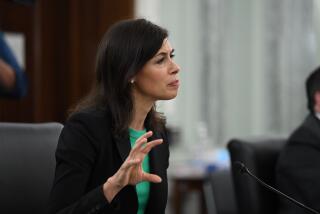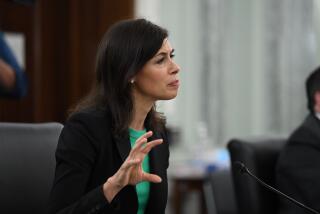Monopolies in the Air
Last year, FCC Commissioner William Kennard proposed closing loopholes that allow TV networks to operate more than one station in the same area. He rightly argued that doing away with the shadowy patchwork of waivers that federal regulators began permitting in 1989 would help ensure diversity in TV station ownership and variety in program content.
Broadcasters, however, howled in opposition, and the results of their clout will be evident next week when the Federal Register publishes new rules that, far from closing loopholes, do away with the nation’s dual ownership ban in most of the nation’s top 50 media markets.
Kennard’s retreat, which came after legislators sympathetic to broadcasters threatened to undermine the FCC’s regulatory authority for good, could accelerate TV industry consolidations that have in the last decade made it hard for minorities, women and new parties in general to buy stations.
The danger is that TV will now experience the fate of radio after Congress lifted that industry’s ownership caps in 1996. The result was a buying spree by major radio companies that raised station prices beyond the means of local owners and contributed to the current dearth of independent voices on the radio dial.
The broadcast networks say they need deregulation to compete with cable and the Internet, which have no ownership caps. But the government has already given the broadcasters a huge competitive advantage in the new media game. In 1996, Congress handed the broadcast networks, without charge, a portion of the public airwaves that would have fetched taxpayers about $70 billion had it been auctioned off instead. Most broadcasters acknowledge that the FCC decision will send station prices soaring to levels that only networks can afford. That’s of no small concern, for according to the National Assn. of Black Owned Broadcasters, minorities own just 20 TV stations out of more than 1,500.
A group of broadcasters led by CBS President Mel Karmazin has proposed that networks help by establishing a $200-million kitty to assist potential minority buyers. That sum, however, would hardly be enough to buy even one station. Wall Street analysts expect that the first station to be sold after the lifting of the dual ownership rule, KCAL-TV in Los Angeles, will go not for the $376 million that its current, nonnetwork owner, Vincent Young, paid for it three years ago but for about $800 million. Other stations will undoubtedly be sold for far less than that channel, which is highly coveted because of the number of “eyeballs” in Southern California. Even so, it’s clear that broadcasters’ vague commitment to help minorities is at best a partial solution.
It is unlikely that the new FCC rules will be overturned, for only three legislators have opposed them so far. Broadcasters, who have won this round, are now furiously lobbying to eliminate the last remaining ownership restriction, which blocks a single owner from reaching more than 35% of national households. The FCC, which is proving itself no friend of consumers, should at least preserve this last shred of local-ownership encouragement. The public interest, after all, is the principle the FCC is supposed to uphold above all else.
More to Read
The biggest entertainment stories
Get our big stories about Hollywood, film, television, music, arts, culture and more right in your inbox as soon as they publish.
You may occasionally receive promotional content from the Los Angeles Times.










